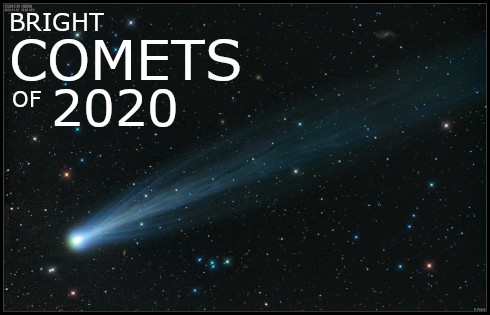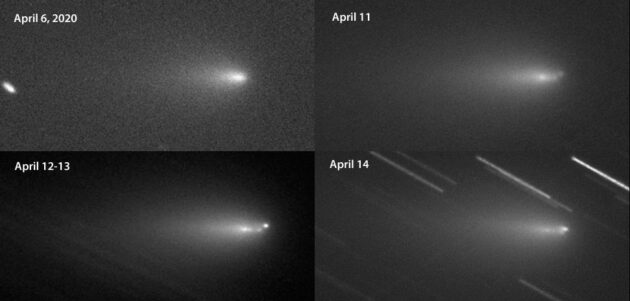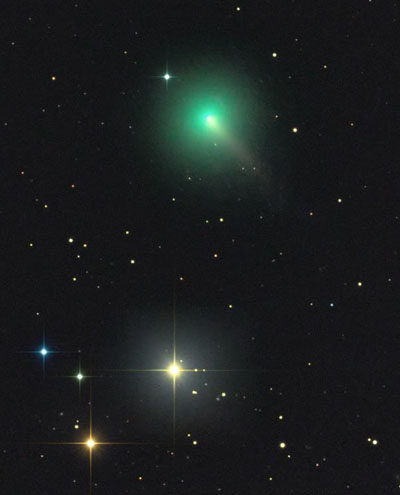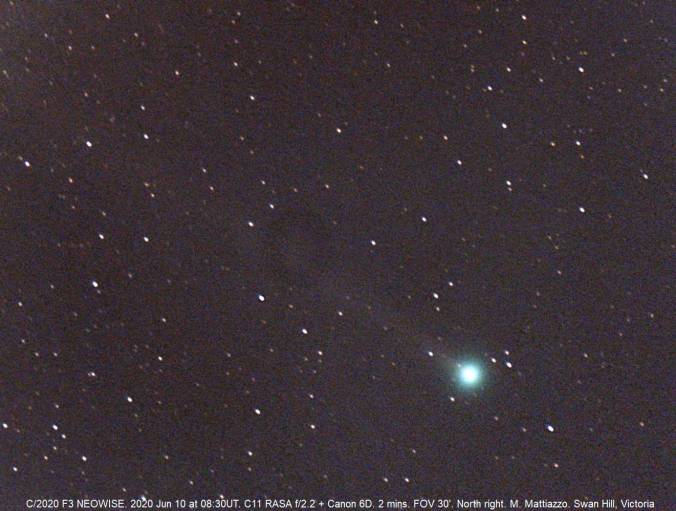
Last year, Comet 46P/Wirtanen continued to put on a reasonable 5th magnitude show at the beginning of the year following on from from its 2018 perihelion.
Also, long period comet Iwamoto (C/2018 Y1) reached magnitude 6. We also enjoyed around 50 new comet discoveries and 17 recoveries. Relative excitement continued over interstellar comet 2I/Borisov. With all that activity not one of these comets resulted in a naked eye object or one that even became easily visible in binoculars.
So what’s in store for 2020? At the beginning of 2020, forecasts suggested that enthusiasts may have to become resilient towards any high expectation. This year we are served up a small flurry of comets all of which remain within telescopic realm of visual brightness.
Comet C/2019 Y4 (ATLAS) hoped to change all this!
Comet 2019 Y4 (ATLAS)
Newly discovered comet C/2019 Y4 (ATLAS) is a near-parabolic comet that was discovered last December by the Asteroid Terrestrial-impact Last Alert System survey in Hawaii. This object has the potential to become a truly great naked eye comet. Or.. it could fizzle out before it gets the chance to.
At the time of writing, the comet had brightened some 600-fold from 20th magnitude in December 2019 to 8th magnitude in March 2020. This is an unprecedented rate of increase and many astronomers believe that comet Atlas cannot maintain such a rate all the way to perihelion on 31 May.
Peak brightness predictions varied greatly with some forecasting a whopping visual magnitude of -11 while other’s suggest a more conservative magnitude +2. Either way, most predictions fell within naked eye visibility.

All hopes were dashed by the end of March however when the comet broke apart and fizzled out right at the time it was expected to become well placed for observation. For more information, diagrams and finder charts, visit our more detailed article on Comet C/2019 Y4 (ATLAS)
Comet C/2020 F8 (SWAN)

On 25 March, Comet C/2020 F8 (SWAN) was discovered by the Solar and Heliospheric Observatory’s SWAN camera. The newcomer was residing in the constellation of Pisces Austrinus in the southern hemisphere at 8th magnitude.
While Coronavirus lock-downs we’re in full swing, this newcomer was expected to put on a show through April and May.
Once again however enthusiasts were disappointed as the icy rock emerged in the pre-dawn skies for northern observers in May. The comet had decreased in magnitude and faded away contrary to expectation.
Comet C/2020 F3 (NEOWISE)

Discovered on 27 March, 2020 by NASA’s Wide-field Infrared Survey Explorer telescope. Comet C/2020 F3 (NEOWISE) had brightened to visual magnitude 7.0 by mid-June. Predicted to dramatically increase in brightness as the icy rock flirts with the Sun in July, the comet has not disappointed (finally positive predictions came true).
Where is Comet NEOWISE?
At the time of updating this article, the comet has reached magnitude 1 residing in Auriga poised to head northward through Lynx and Ursa Major by the end of July. This will bring the icy rock out of early morning twilight and hopefully with a nice extended tail. See our dedicated page for more information and finder charts
Comet 289P/Blanpain
Short period comet 289P/Blanpain reaches closest approach to Earth on 10 January 2020 at a distance of 0.089 AU, however was predicted to reach around magnitude 15, this proved to worsen with actual observations peaking at mag. 18.
Comet 2017 T2 (PanSTARRS)
2017 T2 starts the year well placed for UK and northern hemisphere observers close to the zenith each evening in the constellation of Perseus. The comet passes the famous Perseus double cluster from 26-30 January, an opportunity for any astrophotographers out there.
The comet remains well placed for the first half of the year passing close to the pair of M81 & M82 galaxies in May. At the same time, observers will be battling with the ever looming light summer nights before it passes countless galaxies in Canes Venatici. By August, comet 2017 T2 will be sinking in to the twilight sky visible only in telescopes.
At the time of writing this comet is shining at magnitude 9.5 keeping it only visible through telescopes and good-sized binoculars.
Comet 88P/Howell
This short period comet was discovered in 1981 by Ellen Howell. For UK observers this comet is a convenient evening object until it is lost in the summer twilight by June. It is better placed for Southern Hemisphere observers who may witness the object reaching 5th magnitude.
29P/Schwassmann-Wachmann
29P is an annual short period comet that has famously endured several outbursts over recent years. The comet is in solar conjunction through March and at opposition in October.
By the second half of 2020, 29P should be readily visible from the Northern hemisphere. At the time of writing, Comet 29P/Schwassmann-Wachmann is hovering around magnitude 14.5, however as said before this is always ‘one to watch’.
